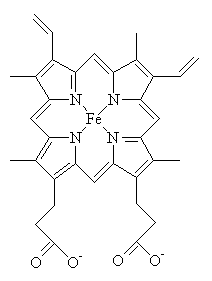
Iron

Solid iron is shown above. Iron forms Fe(II)-haem by placing itself in the centre of the porphyrin ring. In oxygenated myoglobin and haemoglobin it also forms bonds to a Histidine residue in the haemoglobin/myoglobin protein and an oxygen molecule. The 2D and 3D representations below do not show the oxygenated form.

(The 3D structure can be manipulated by moving the mouse over the image with the left button selected):
Function:
Iron is required for the efficient transport of oxygen around the body, and for the prevention of anaemia. Anaemia is characterised by tiredness and palpitations initially, leading to dizziness and shortness of breath or even angina in severe cases. The RDA for men is 8mg, for pre-menopausal women it is 18mg. Pregnant women require 27mg due to the demands of the growing fetus. The UL for iron consumption is 45mg, above which gastrointestinal irritation may occur. Iron can be stored in the liver if a small excess is consumed.
Mechanism:
Each red blood cell is full of 250 million haemoglobin molecules, each haemoglobin molecule has four Fe(II)-haem groups, which can accept an oxygen molecule each, giving a grand total of 1000 million oxygen molecules transported by each red blood cell.
Sources:
Good sources of iron include liver, beef, wholemeal bread, cereals, eggs and dried fruit. A good diet should not need supplementing with pills, although pregnant women may benefit from a low dose supplement.
Fascinating Fact: Red blood cells have a life span of 120 days, which the bone marrow replaces at a rate of 1.5 million a second.